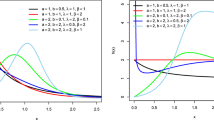Abstract
The history of queueing theory, particularly over the first sixty years after Erlang’s 1909 paper, is summarised and assessed, with particular reference to the influence of Pollaczek and Kendall. The interactions between the world of telephone traffic and that of applied probability and operational research are a significant factor. The history is followed by speculation about the directions in which the theory might now develop, in response to new problems and new possibilities. It is suggested that classical unsolved problems like the queue M/G/k might be revisited, and that non-renewal inputs might be handled by martingale techniques.
Similar content being viewed by others
References
Asmussen, S.: Applied Probability and Queues. Springer, New York (2003)
Brockmeyer, E., Halstrøm, H.L., Jensen, A.: The Life and Works of A.K. Erlang. Akademiet for de Tekniske Videnskaber, København (1948)
Cohen, J.W.: The Single Server Queue. North-Holland, Amsterdam (1969)
Cox, D.R.: Some statistical models related to series of events. J. R. Stat. Soc. B 17, 129–164 (1955)
Feller, W.: An Introduction to Probability Theory and Its Applications. Wiley, New York (1950)
Fry, T.C.: Probability and Its Engineering Uses. Van Nostrand, New York (1928)
Kelly, F.P.: Reversibility and Stochastic Networks. Wiley, London (1979)
Kelly, F.P., Zachary, S., Ziedins, I. (eds.): Stochastic Networks: Theory and Applications. Oxford University Press, Oxford (1996)
Kendall, D.G.: Some problems in the theory of queues. J. R. Stat. Soc. B 13, 151–173 (1951); discussion 173–185
Kendall, D.G.: Stochastic processes occurring in the theory of queues and their analysis by the method of the imbedded Markov chain. Ann. Math. Stat. 24, 338–354 (1953)
Khinchin, A.Y.: Mathematical Methods in the Theory of Queueing. Griffin, London (1960)
Kingman, J.F.C.: On queues in which customers are served in random order. Proc. Camb. Philos. Soc. 58, 79–91 (1962)
Kingman, J.F.C.: The use of Spitzer’s identity in the investigation of the busy period and other quantities in the queue GI/G/1. J. Aust. Math. Soc. 2, 345–356 (1962)
Kingman, J.F.C.: On doubly stochastic Poisson processes. Proc. Camb. Philos. Soc. 60, 923–930 (1964)
Kingman, J.F.C.: On the algebra of queues. J. Appl. Probab. 3, 285–326 (1966)
Kingman, J.F.C.: Regenerative Phenomena. Wiley, London (1972)
Kingman, J.F.C.: Poisson Processes. Oxford University Press, Oxford (1993)
Lindley, D.V.: The theory of queues with a single server. Proc. Camb. Philos. Soc. 48, 277–289 (1952)
Loynes, R.M.: The stability of a queue with non-independent interarrival and service times. Proc. Camb. Philos. Soc. 58, 497–520 (1962)
Pollaczek, F.: Ueber eine Aufgabe der Wahrscheinlichkeitstheorie. Math. Z. 32, 64–100 (1930) 729–750
Pollaczek, F.: Problèmes stochastiques posés par le phénomène de formation d’une queue d’attente à un guichet et par des phénomènes apparentés. Mém. Sci. Math. 136, 1–122 (1957)
Pollaczek, F.: Théorie analytique des problèmes stochastiques relatifs à un groupe de lignes téléphoniques avec dispositif d’attente. Mém. Sci. Math. 150, 1–114 (1961)
Pollaczek, F.: Concerning an analytic method for the treatment of queueing problems. In: Smith, W.L., Wilkinson, W.E. (eds.) Congestion Theory, pp. 1–42. University of North Carolina, Chapel Hill (1964)
Pollaczek, F.: Order statistics of partial sums of mutually independent random variables. J. Appl. Probab. 12, 390–395 (1975)
Saaty, T.L.: Stochastic network flows: advances in networks of queues. In: Smith, W.L., Wilkinson, W.E. (eds.) Congestion Theory, pp. 86–107. University of North Carolina, Chapel Hill (1964)
Sebag-Montefiore, H.: Enigma: The Battle for the Code. Weidenfeld, Nicolson (2000)
Smith, M., Briggs, K., Kelly, F.P. (eds.): Networks: modelling and control. Philos. Trans. R. Soc. A 366, 1875–2092 (2008)
Smith, W.L.: On the distribution of queueing times. Proc. Camb. Philos. Soc. 49, 449–461 (1953)
Smith, W.L., Wilkinson, W.E. (eds.): Congestion Theory. University of North Carolina, Chapel Hill (1964)
Whitt, W.: The impact of a heavy-tailed service-time distribution upon the M/GI/s waiting-time distribution. Queueing Syst. Theory Appl. 36, 71–87 (2000)
Whittle, P.: Systems in Stochastic Equilibrium. Wiley, London (1986)
Author information
Authors and Affiliations
Corresponding author
Additional information
In honour of Agner Krarup Erlang (1878–1929), and of David George Kendall (1918–2007).
Rights and permissions
About this article
Cite this article
Kingman, J.F.C. The first Erlang century—and the next. Queueing Syst 63, 3 (2009). https://doi.org/10.1007/s11134-009-9147-4
Received:
Revised:
Published:
DOI: https://doi.org/10.1007/s11134-009-9147-4




